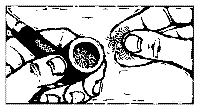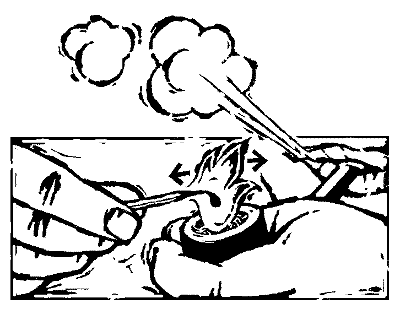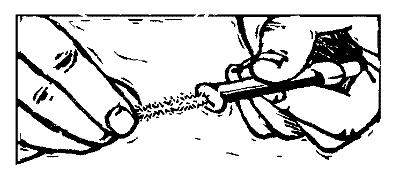Reprinted
with kind permission from The
Pipe Smokers' Council

The
beginner pipesmoker needs to try out a good range of tobaccos in the early
stages. Furtheron we list eleven tobaccos which are easy to smoke, being
ready-rubbed, and easy-burning. They also demonstrate the range of taste,
from mild to medium strength. Many potential pipesmokers have given up
too quickly through a combination of wrong tobacco, and not appreciating
that the experience during the first few times you smoke a new pipe is
nothing like the real flavour which the ‘broken in’ pipe will produce
for you. Ask any regular pipesmoker.
So, you’ve
got your pipe and appropriate tobacco. Here are some easy steps to perfection
.
 First,
pick up your pipe and gently blow through the mouthpiece, to make sure
that the airhole is clear.
First,
pick up your pipe and gently blow through the mouthpiece, to make sure
that the airhole is clear.
 In
order to get the full measure of pleasure from your briar pipe, you will
need to build up a carbonised lining to the entire bowl interior, which
helps insulate the bowl for a cooler, more flavoursome smoke. Nowadays
many pipes come from the factory pre-carbonised. However, with most pipes
it helps to build up your own carbon lining by carefully smoking five
to seven bowlfuls of tobacco with the bowl only half-filled. Over months
of smoking, this lining will gradually thicken, and should be kept trimmed
to about 1/16th of an inch for best results.
In
order to get the full measure of pleasure from your briar pipe, you will
need to build up a carbonised lining to the entire bowl interior, which
helps insulate the bowl for a cooler, more flavoursome smoke. Nowadays
many pipes come from the factory pre-carbonised. However, with most pipes
it helps to build up your own carbon lining by carefully smoking five
to seven bowlfuls of tobacco with the bowl only half-filled. Over months
of smoking, this lining will gradually thicken, and should be kept trimmed
to about 1/16th of an inch for best results.
 Filling
your pipe is the next – and most important – step. If done properly,
your first bowlful should be quite pleasant, but if done incorrectly
your pipe may burn hot and bitter. Filling
your pipe is the next – and most important – step. If done properly,
your first bowlful should be quite pleasant, but if done incorrectly
your pipe may burn hot and bitter. |
| Beware
of tongue bite! That stinging sensation on the tip of your tongue,
that makes many potential pipesmokers abandon the hobby prematurely,
is caused by not filling the bowl correctly and by using tobacco that
is too moist or too dry. |
 |
|

Now
to fill your pipe: holding the pipe upright, trickle in tobacco until
over-flowing. Tamp down gently and repeat the process two or three
more times, until the bowl is full, with a slight springy feel. Draw
through the mouthpiece occasionally, to make sure that it is not plugged
up. |
|
 Lighting
the pipe should preferably be done with a pipe lighter or wooden matches.
The first light is called the ‘charring light’. Its purpose is to create
a charred ‘lid’ of tobacco that will hold the second light. When creating
the charring light, move the flame all around the tobacco, igniting it
completely, but be careful not to scorch the bowl rim. Once completed,
tamp the charred lid down gently. Now you are ready for the second light.
Puff slowly and rhythmically as you ‘walk’ the flame over the charred
tobacco. There! You’ve done it!
Lighting
the pipe should preferably be done with a pipe lighter or wooden matches.
The first light is called the ‘charring light’. Its purpose is to create
a charred ‘lid’ of tobacco that will hold the second light. When creating
the charring light, move the flame all around the tobacco, igniting it
completely, but be careful not to scorch the bowl rim. Once completed,
tamp the charred lid down gently. Now you are ready for the second light.
Puff slowly and rhythmically as you ‘walk’ the flame over the charred
tobacco. There! You’ve done it!

 Because
tobacco is a natural product, it will go out if not puffed regularly so
do not be afraid to use numerous matches throughout your course of pipesmoking.
And it is only natural to eventually hear (or taste) a little gurgle of
moisture in your pipe: this is a by-product of combustion. In addition,
some people ‘smoke wet’ and these natural juices should be immediately
removed by running a pipe cleaner down the airhole, retamping the tobacco,
and relighting if necessary.
Because
tobacco is a natural product, it will go out if not puffed regularly so
do not be afraid to use numerous matches throughout your course of pipesmoking.
And it is only natural to eventually hear (or taste) a little gurgle of
moisture in your pipe: this is a by-product of combustion. In addition,
some people ‘smoke wet’ and these natural juices should be immediately
removed by running a pipe cleaner down the airhole, retamping the tobacco,
and relighting if necessary.
 It is very important to look after your pipe properly. Taken care of,
your pipe will last for many years, improving with age. A pipe for every
day of the week is desirable rather than necessary, but certainly two
pipes are better than one.
It is very important to look after your pipe properly. Taken care of,
your pipe will last for many years, improving with age. A pipe for every
day of the week is desirable rather than necessary, but certainly two
pipes are better than one.

You
should never refill a pipe when it is still warm. Clean the stem regularly
by the simple process of pushing a pipe cleaner through it. For metal
stemmed pipes, the use of a chemical spray is recommended.

As mentioned in point 2, the inside of the bowl will over months of smoking
acquire a black coating of carbon. This is desirable and will ensure that
you get the full flavour of your favourite tobacco. If the coating gets
too thick, however, the pipe will start to burn hot. When this happens
the coating should be carefully shaved down with a smoker’s knife – not
an ordinary penknife. You will find that a pipe reamer is a very useful
aid to cleaning. Careful treatment and storage of your pipe will prolong
its life.

Reprinted with kind permission from The
Pipe Smokers' Council